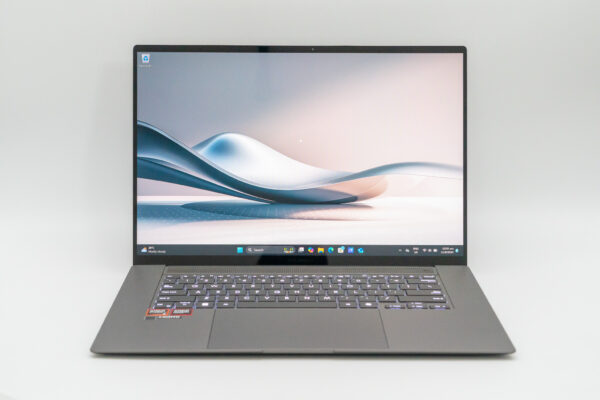
New AI PCs powered by AMD’s brand-new series of Ryzen AI processors were just announced in July. I have one of ASUS’ new AI PC, the Zenbook S 16 UM56056, and I’m excited to find out how it performs, and especially how the new AMD processors stack up against Qualcomm’s Snapdragon X processors.
We are at the dawn of the new era of AI PCs. There is no doubt that the AI is a lot of marketing hype. However, I think we are witnessing a step up in the technologies that power our computers. The ARM-based Qualcomm Snapdragon X processors that power Copilot+ PCs announced in June is a significant milestone, a moment that in some ways is comparable to when Apple transitioned from Intel processors to their own ARM-based processors. As transformative as the Snapdragon processors might potentially be, AMD was hot on Qualcomm’s heels with their Ryzen AI 300 Series processors.
Ryzen AI is promised to be performant and efficient, and also features dedicated NPU for AI tasks. It’s like Qualcomm’s Snapdragon X, except that it’s still x86-based so it won’t face any compatibility quirkiness like the latter would. This is an exciting time, not just because of what Qualcomm and AMD have on the table now, but also that we are expecting Intel to join the party soon.
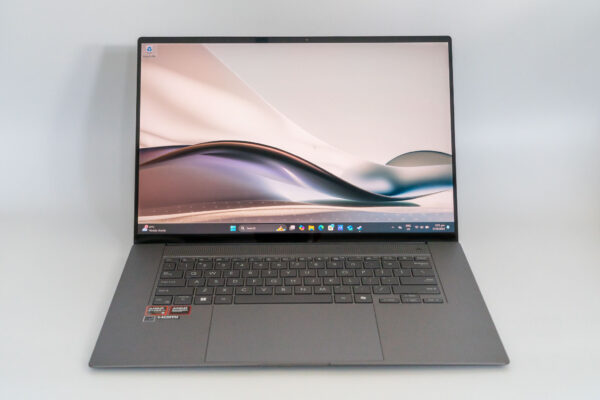
The ASUS Zenbook S 16 UM5606 is a large ultra-thin laptop with an expansive 16-inch OLED screen and powered by AMD Ryzen AI 9 365 processor. It’s very thin, measuring just 35.36 x 24.30 x 1.19 ~ 1.29 cm (WxDxH), and weighs just 1.50 kg.
ASUS has been constantly changing up their laptop designs in recent years, so there isn’t really a kind of easily identifiable signature look. That may be a good thing since it allows their design team to experiment with new ideas. In the case of this new Zenbook S 16, they’ve gone with something rather unique in the choice of materials used for the chassis.
It’s not plastic, it’s not aluminium, nor is it some carbon composite. Instead, ASUS has created something called Ceraluminum — aluminium that has been fused with ceramic. Ceraluminum is used only on the back of the display, not for the entire chassis. It does give the Zenbook S 16 a rather unique look and feel.
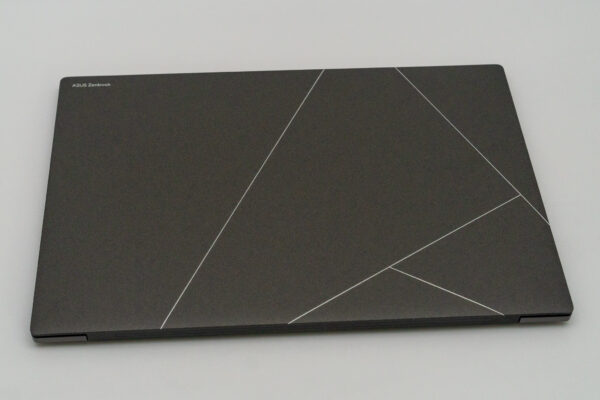
Ceraluminum feels a bit like plastic. It feels like a very mildly textured plastic. It is not cold to the touch like you’d expect metal to be. You can feel it’s rigid and sturdy. In fact, the material resists flexing quite well. The ceramic coating resists fingerprints and even scratches. Some metal lines across the back of the display add some character. This new design is nice and functional, though I would not categorise its style as something that would sell the laptop.
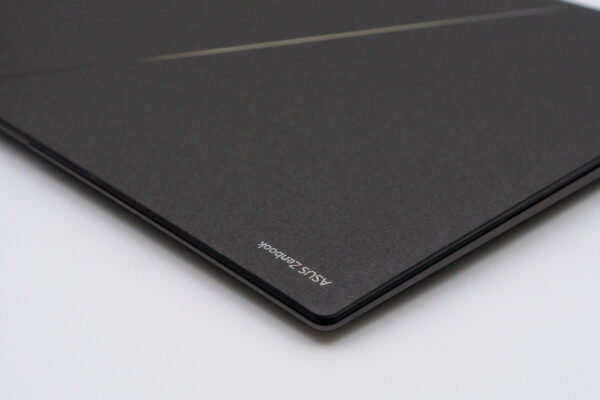
The Zenbook S 16 exudes some qualities of a precision engineered product. Even if the ceraluminum doesn’t impress you, I think the ventilation holes on the keyboard deck might. It’s not just an array of precisely drilled holes. That would be boring. In fact, the larger and more apparent holes aren’t actually drilled through. Instead, there are two tinier holes within that larger one that are the ones drilled through the material. It looks quite cool, and yes, that’ll also keep the Zenbook S 16 cool.
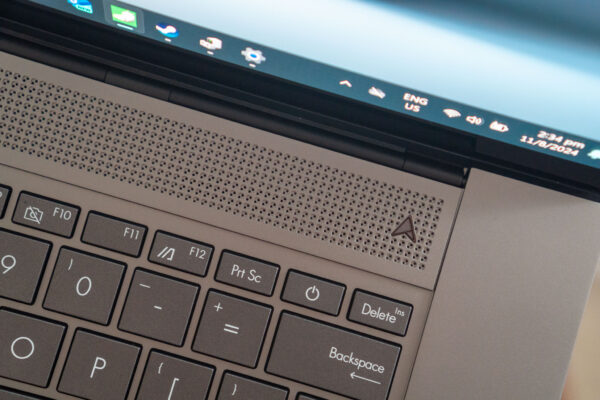
Let me quickly run through the main specs of the Zenbook S 16. It has an expansive glossy 16-inch OLED display with 3K resolution (2880 x 1800) and a 16:10 aspect ratio. This is an excellent display that boasts 0.2 ms response time, 120 Hz refresh rate, 400 nits of brightness, and 500 nits HDR peak brightness. It is VESA-certified and Pantone validated.
I ran my own Sypder5PRO colourimeter test and found the display to cover 100%, 93%, 96%, and 96% of the sRGB, NTSC, AdobeRGB, and P3 colour gamut respectively. (I know, I have DisplayCal in the photo below; I was trying out the software.) This being an OLED screen, the blacks are absolutely black. Overall, this is a great colour-accurate display.
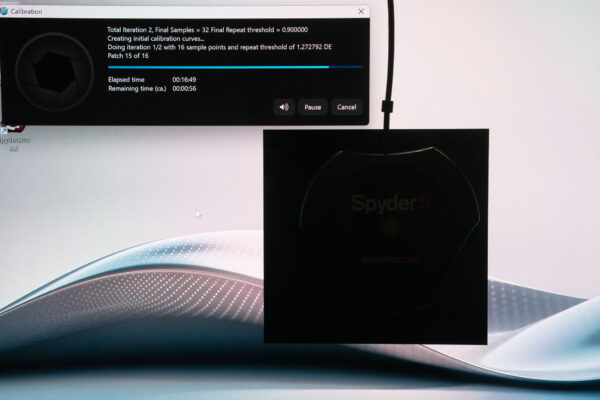
There’s just one disappointment I have with the display. It does not support touch or pen input. For a laptop in its price category, I thought there should at least be touch support.
There is a Full-HD camera above the screen. It has IR function and supports Windows Hello facial recognition.
The keyboard is spacious and comfortable to type on. The 1.1 mm key travel may seem like not much, but they have good tactile feedback and provide a good typing experience. The chiclet keys have a standard layout, along with a proper inverted-T navigation arrow-keys arrangement. It’s the generation of AI PC, so there’s also now a Copilot key.
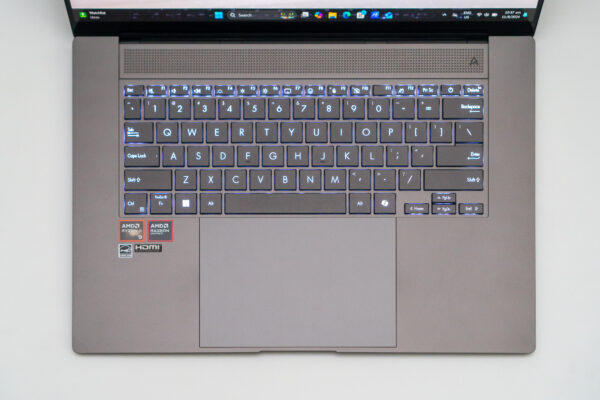
The touchpad is huge. In fact, it is humongous, stretching over 7-inches diagonally. This is a standard mechanical touchpad that physically moves when you click. This won’t bother some people much if you’re used to touch-tapping to click.
ASUS has been making their touchpad double-up as a number pad in many of their laptops. No more this time. It’s been replaced by a new feature. Refer to the photo below with the instructional overlay on the touchpad. Sliding gestures along the edges can be used to control volume, screen brightness, and even to rewind/forward through video play. I think it’s mostly gimmick. It’s hard to control anything precisely, and I don’t expect I’d prefer to use this over dedicated keys on the function key row. Though, in a pinch, it might be easy to dial down the volume quickly, if you remember which edge of the touchpad to swipe.
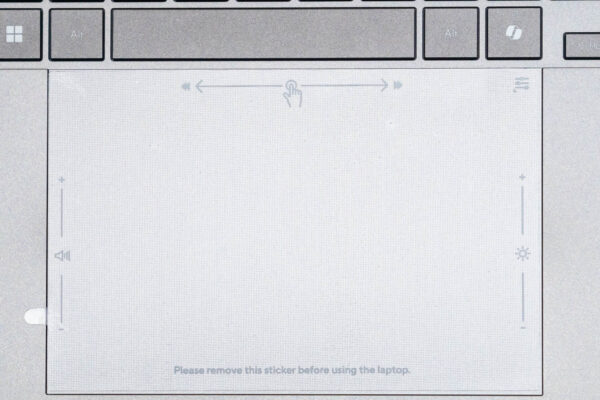
Audio on the Zenbook S 16 is produced by six-speakers system. The sounds is decent and can get loud. It also has an array microphone system.
The port situation on this laptop is perhaps the minimum you’d expect from one of this size. Starting on the left side, there’s a HDMI 2.1 port, 2x USB 4.0 Gen 3 Type-C ports with display and power delivery, and a 3.5 mm combo audio jack.
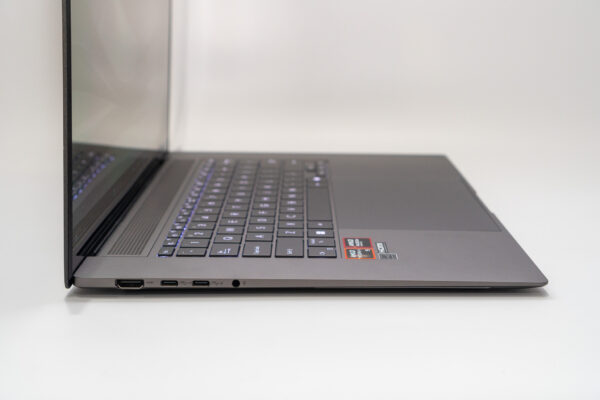
On the other side, there’s a USB 3.2 Gen 2 Type-A port, and a full-sized SD card reader. You’d have thought a laptop with a 16-inch display will have enough space for more ports, but I think the thinness of the Zenbook S 16 makes it hard to put anything more. Already, the HDMI port and USB Type-A port barely fit.
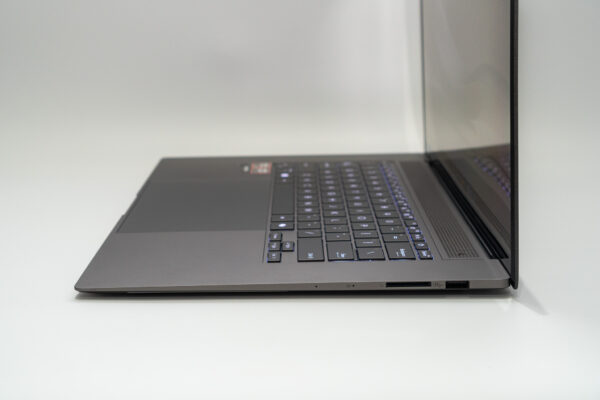
For connectivity, the Zenbook S 16 has Wi-Fi 7 tri-band with 2×2 radios, and Bluetooth 5.4. ASUS says you could get up to three simultaneous Bluetooth headphone connections
My Zenbook S 16 review unit is powered by AMD Ryzen AI 9 365 processor and AMD Radeon 880M graphics. The NPU in the processor, AMD calls it AMD XDNA NPU, can perform up to 50 TOPS. This does meet Microsoft’s requirement of 40 TOPS to qualify to be a Copilot+ PC, but this laptop is not (yet) certified as one.
There is 24 GB of LPDDR5X and 1 TB M.2 NVMe PCIe 4.0 storage. You can upgrade the storage; it uses a M.2 2280 slot.
For power, the Zenbook S 16 has a 78 WHr battery, and it ships with a 65 W USB Type-C power adapter.
Let’s look at some benchmarks. The Zenbook S 16 tends to step down its performance while running on battery, so I ran my tests both plugged-in and unplugged to give you a sense of how the laptop will perform under these different conditions. In all tests, the power mode was sent to Balanced when on battery, and Best Performance when plugged-in.
| PCMark 10 Extended | On battery | Plugged-in |
| Overall | 5105 | 7027 |
| Essentials | 7282 | 10462 |
| Productivity | 5503 | 10532 |
| Digital Content Creation | 7018 | 9209 |
| Gaming | 6526 | 6495 |
Oddly the gaming test was poorer when plugged in.
I thought it may be interesting to compare the new AMD Ryzen AI processor with the Qualcomm Snapdragon X processor. I have on hand a Surface Laptop 7 with the lower-end Snapdragon X Plus processor, and although this laptop is not quite in the same size/weight category, it may still offer some interesting insights into how these two processor platforms compare.
Here are the scores for Geekbench 6.
| Geekbench 6 | Zenbook S 16 (battery/plugged-in) | Surface Laptop 7 (battery/plugged-in) |
| Single-Core | 1508 / 2778 | 2305 / 2452 |
| Multi-Core | 8487 / 12890 | 12502 / 13295 |
| GPU | 28785 / 29386 | 19215 / 20045 |
First, you can see that the Surface Laptop 7’s performance doesn’t drop much running on battery compared to when plugged-in. The AMD Ryzen AI 9 365 clearly wins in GPU performance, but the Snapdragon X Plus is largely comparable in CPU performance (the latter edges out in multi-core, but loses slightly in single-core).
Here are the Cinebench R26 scores.
| Cinebench R24 | Zenbook S 16 (battery/plugged-in) | Surface Laptop 7 (battery/plugged-in) |
| Single-Core | 60 / 111 | 105 / 109 |
| Multi-Core | 611 / 739 | 697 / 762 |
Plugged-in, both laptops are largely comparable, but the Zenbook S 16 definitely caps its performance too much when running on battery.
For my simple battery test, I ran both laptops using a Full-HD video loop on YouTube.
| YouTube Video Loop | Zenbook S 16 | Surface Laptop 7 |
| Runtime | 12 hrs 45 mins | 18 hrs 54 mins |
The Surface Laptop 7 with Qualcomm Snapdragon X Plus definitely takes the crown by a wide margin.
The Zenbook S 16 with AMD Ryzen AI 9 365 lasting on battery for as long as it did is really excellent when compared to other Intel and AMD laptops that came before it. At 12 hr and 45 min, the laptop will take you through your entire workday and then some. It’s impressive considering it has a large high-resolution and high-refresh rate OLED screen. However, I had expected with AMD’s brave claim of power efficiency in their new chips that they will be closer on the heels of the Snapdragon X. Alas, that is not the case.
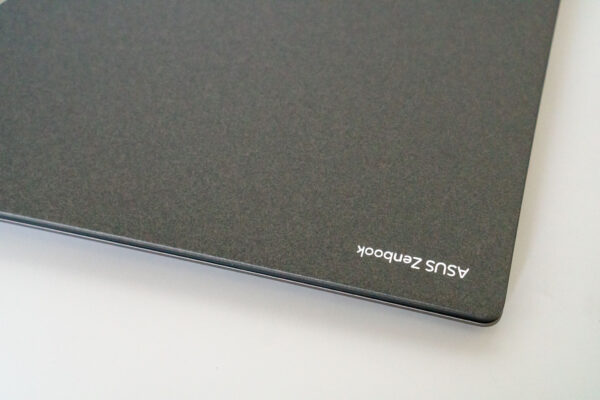
Let me switch gears to talk about AI in the Zenbook S 16, and specifically what the AMD XDNA NPU is for. When Microsoft launched Copilot+ PCs with Snapdragon X processors, they had a pitch about how some selected software were taking advantage of the Hexagon NPU. AMD is doing something similar by working with a few companies to launch new versions of software, some still in beta, that take advantage of their AMD XDNA NPU.
For example, AMD partnered TensorStack to bring Amuse, an easy-to-use software that enables you to create AI art using the latest Stable Diffusion models on your PC. You can generate images from prompts, apply custom AI filters to your photos and images, and draw new art with AI collaboration. Amuse works on Windows PCs using CPU or GPU too, but the most powerful AI creative tools are only available with AMD XDNA.
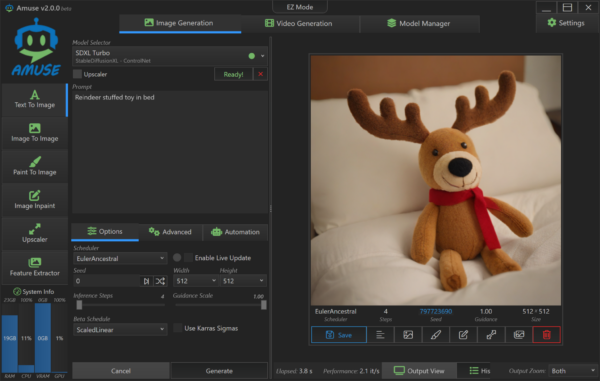
Next, there’s also a collaboration with Reincubate to produce a version of Camo Studio, currently still in beta but a public release will come soon, that uses AMD XDNA to enhance your video streaming/conferencing experience. Camo Studio provides the tools to apply filters, text overlays, auto-zoom, and create an emoji hand, among others.
There’s also ArkRunrOne for more serious video content creators. They will have a full public release with Ryzen Ai integration later this year. AMD XNA NPU is used to handle automatic backgroud removal.
AMD seems to have made gone to greater lengths to showcase more capabilities that they can bring with the AMD XDNA NPU, more so than Microsoft has done with Qualcomm on Copilot+ PCs, although not all of the software have a public release right now.
Whether the ASUS Zenbook S 16 works for you, however, likely shouldn’t be based on the AI capabilities of the AMD Ryzen AI processor. The AI is a feature that capitalises on capabilities of the processor, not a specific laptop brand or model. Furthermore, NPU capabilities are going to become more prevalent in any processor, from Intel or AMD, and indeed also the Qualcomm Snapdragon X. New generation of laptops this year on will all have some sort of NPU.
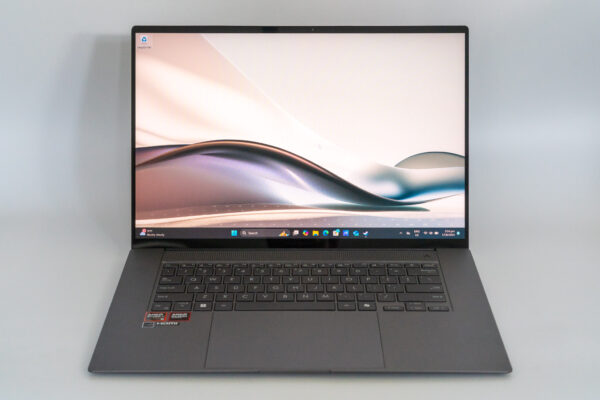
What does the ASUS Zenbook S 16 bring to the table?
It’s an ultra-thin large-screen laptop with excellent screen, powerful graphics performance, great keyboard and touchpad, and being x86-based, has no ARM compatibility issues. 24 GB RAM is a nice upgrade to have. The battery life is great compared with laptops powered by previous generation Intel and AMD processors, but if battery life is very important, you should know that laptops powered by Snapdragon X processors are definitely still ahead of the game.
This ASUS Zenbook S 16 UM5606 as configured (24 GB RAM and 1 TB storage) retails at $2,549.
1 thought on “ASUS Zenbook S 16 UM5606”
View Comment Policy